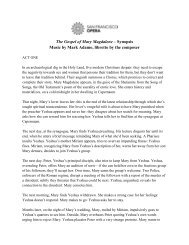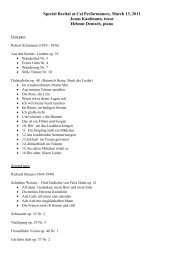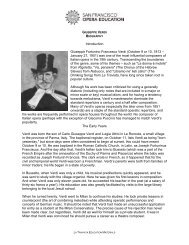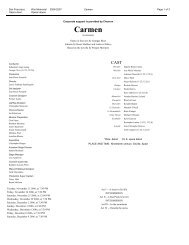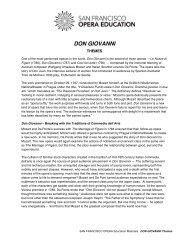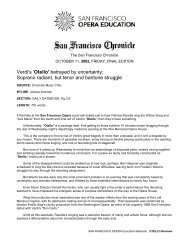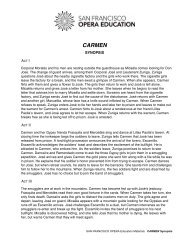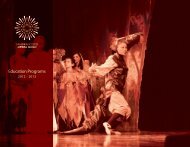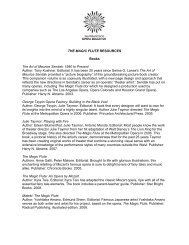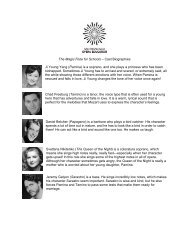The Rake's Progress Teachers Guide - San Francisco Opera
The Rake's Progress Teachers Guide - San Francisco Opera
The Rake's Progress Teachers Guide - San Francisco Opera
Create successful ePaper yourself
Turn your PDF publications into a flip-book with our unique Google optimized e-Paper software.
<strong>The</strong> Lighting Designer works with the Director to create the lighting for the production. Lighting is central<br />
to the mood of the opera; a scene set in bright white light has a different feeling than one set in softer blue<br />
lighting, which may denote evening or a romantic scene.<br />
<strong>The</strong> Costume Designer is responsible for working with the rest of the creative<br />
team to decide what the dress for the characters will be. On a historically based<br />
production, the Costume Designers do background research into the time period<br />
to make sure that the dress is as appropriate as the sets are. In the case of period<br />
operas, such as Macbeth, many Costume Designers have done research into the<br />
time period to see how the people of the time would have dressed, and to assure that the cast has costumes<br />
that their characters might actually have worn. On productions with more abstract concepts, the Designer<br />
uses more of his or her own imagination to design costuming. A team of sewing experts, or stitchers, then<br />
sets to actually measuring performers and assembling the costumes.<br />
<strong>The</strong> Props Master is responsible for finding, designing and/or constructing the props that will be used on<br />
stage. This can include everything from clothing accessories like purses, to swords, to wall lamps, to giant<br />
puppets. <strong>The</strong> Props Designer also works with a crew of craftspeople who take care of the properties after<br />
they have assembled them. When any opera is in production, a huge amount of creative collaboration is<br />
required throughout the departments in order to arrive at the end result, the fully staged opera.<br />
Backstage there are sometimes hundreds of people working to make sure that the people on stage<br />
are under the right lighting and have the right props and backdrops. <strong>The</strong>se are the Stage Crews;<br />
they are responsible for running the show- making sure everything happens in the right place, at<br />
the right time.<br />
<strong>The</strong> Stage Manager is the conductor of movement on and off stage. <strong>The</strong> Stage Manager really runs the<br />
show backstage, usually connected to several different areas on a headset. She often relies on video<br />
monitors, as well as audio communication, to keep on top of what is happening at any moment during the<br />
production. <strong>The</strong> Sound Crews maintain the audio and video equipment that keep the Stage Management<br />
team in the know. <strong>The</strong> Stage Manager and his or her assistants are responsible for calling lighting and<br />
sound cues, being sure that artists are available for their entrances, and coordinating the chorus and<br />
supernumeraries, or extras, in crowd scenes that are often large and difficult to manage. For that reason, in<br />
the very short rehearsal time they try to perfect large scenes so that the confusion backstage is minimal and<br />
the masses move at the right times.<br />
In opera, the Stage Manager must know how to read music and follow a score, the book containing the<br />
music and text for the opera. This way, he or she can follow along with the Conductor and understand<br />
where the opera is going, in order to be prepared for the next scene at all times. <strong>The</strong> Stage Manager’s score<br />
is usually filled with notes and markings so that they remember all the cues that fill the opera. <strong>The</strong> people on<br />
the other end of headsets attached to the stage manager can range from electricians, to sound specialists, to<br />
carpenters who have built the sets, to costume staff waiting to help the artists change in the wings (the area<br />
off-stage to the sides).<br />
45



